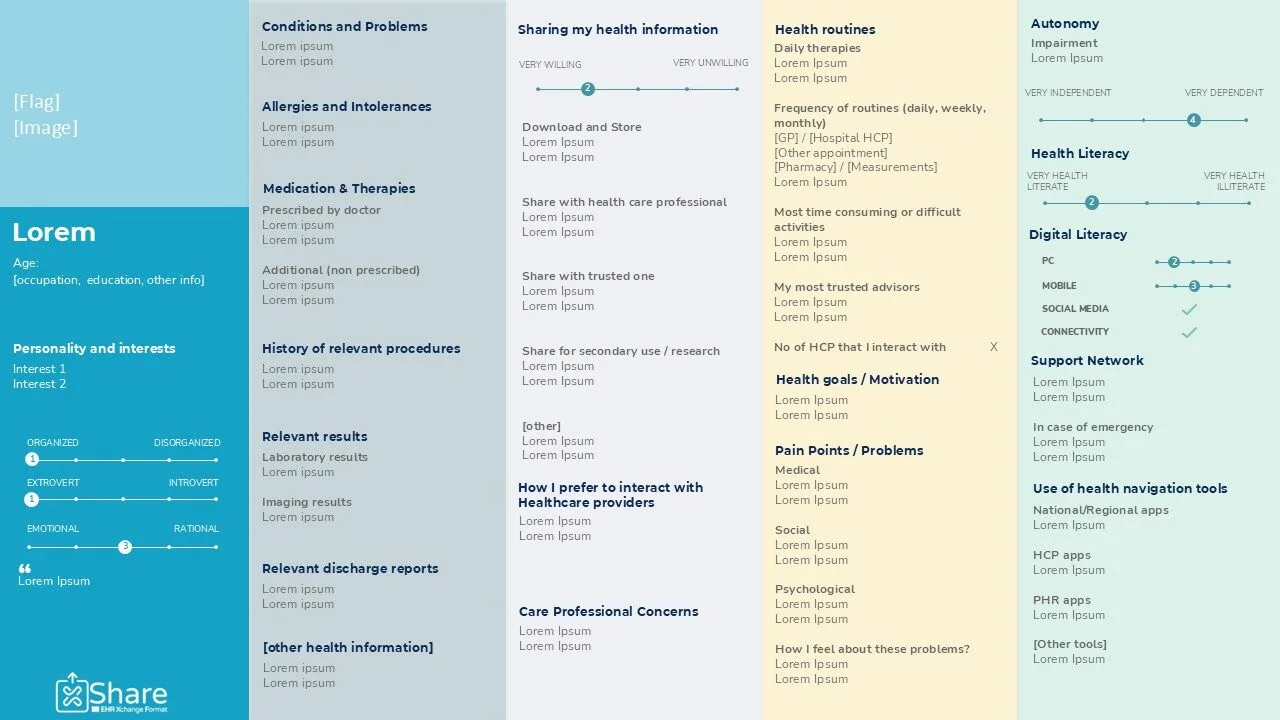The adoption of new digital health tools often fails not because of technological limitations, but due to a lack of alignment with real user needs and clinical realities. This is especially true for solutions that aim to empower citizens directly, such as the xShare Yellow Button—a tool designed to make it easier for individuals to access, manage, and share their personal health data in a trusted and standardized way.
To support the successful adoption and deployment of the xShare Yellow Button, a structured methodological approach is used, combining three elements: a use case template adapted from the Antilope EU project, user stories for requirement gathering, and personas based on the model developed by the Gravitate Health EU project. Together, these elements ensure that design and evaluation are technically robust, clinically relevant, and genuinely citizen-centered.
The first component, the use case template, provides the structural backbone of the methodology. Adapted from the Antilope project’s work on eHealth interoperability, it helps define and document how the xShare Yellow Button should function in real-world settings. This includes identifying the key actors (such as citizens, general practitioners, pharmacists), the digital systems involved (like patient portals, EHRs, mobile apps), the goal of each scenario (e.g., “sharing patient summary with a new clinician”), and the standards that underpin the data exchange (such as HL7 FHIR). Crucially, this template ensures that interoperability and compliance are embedded from the outset, which is essential for adoption at scale within European health systems.

Building on the structural clarity of the use case, the methodology incorporates user stories to capture specific needs and expectations in the voices of different users. These stories take the familiar format—“As a [type of user], I want [functionality] so that [benefit]”—and are collected through interviews, co-design sessions, or contextual inquiry. For example, a story might be: “As a Patient, I want Share personal history with a new GP/healthcare provider so that I can precisely report my history of illnesses and treatments, as collected in my last encounter, leading to an improved precision on history data collection.” These stories are invaluable for translating abstract system objectives into actionable features that directly respond to user motivations and contexts.
To ensure that user stories reflect the diversity of real-life experiences, the third pillar of the methodology is the use of personas, adapted from the Gravitate Health framework. Each persona represents a realistic archetype of a potential xShare Yellow Button user, complete with background, health status, digital literacy, goals, and barriers. For instance, one persona might be a tech-savvy adult managing a chronic condition who frequently travels and needs to share data internationally, while another might be a caregiver supporting a parent with limited digital access. These personas help development teams and stakeholders keep real users in mind during design, implementation, and evaluation phases.
Why This Matters
Together, these three tools—use cases, user stories, and personas—provide a practical, modular, and user-centered methodology for guiding the adoption of the xShare Yellow Button. They ensure that the solution is not only compliant with health data standards and privacy regulations but also relevant, usable, and trusted by the people it is meant to serve.
In this way, the methodology moves beyond abstract design principles to offer a concrete path from needs assessment to real-world deployment. It enables cross-disciplinary teams to align on expectations, validate features through co-design, and anticipate barriers to adoption—making it particularly suited for public-sector innovation and large-scale digital health initiatives. The result is a more inclusive, interoperable, and impactful tool that empowers citizens to manage their health data with confidence.
For additional information, check the list of use cases at Link to use cases at https://usecase-repository.ihe-europe.net/xshare-use-cases/.
–
Written by Maria Marques, PhD, Principal Researcher, UNINOVA.
Contact the author at mcm@uninova.pt.
About the author: Maria Marques, PhD in Electrical and Computers Engineering with more than 20 years of experience in research and innovation for building environments where technology is at a service of populations and a key enabler for digital health. Research interests include data management and connected infrastructure of wearables, (medical) smart devices, software applications, integrated in health systems as mean to provide better and more personalised services for the society as whole. Principal researcher at UNINOVA (www.uninova.pt). Member of the board for innovation and development at IDEA (www.idea-institute.pt). Independent expert close to the European Commission in the areas of Artificial Intelligence, Internet of Thigs (IoT), interoperability and decision support systems, among others. Leader of international and multidisciplinary teams in several R&I projects funded by the European Commission such as Smart4Health (deputy coordinator), XpanDH and i2X (leader of demonstration). Co-leader of xShare patient-mediated health data exchange use cases. Author of several scientific publications, many of them debating the usage of technology to ensure seamless integration in health environments.
